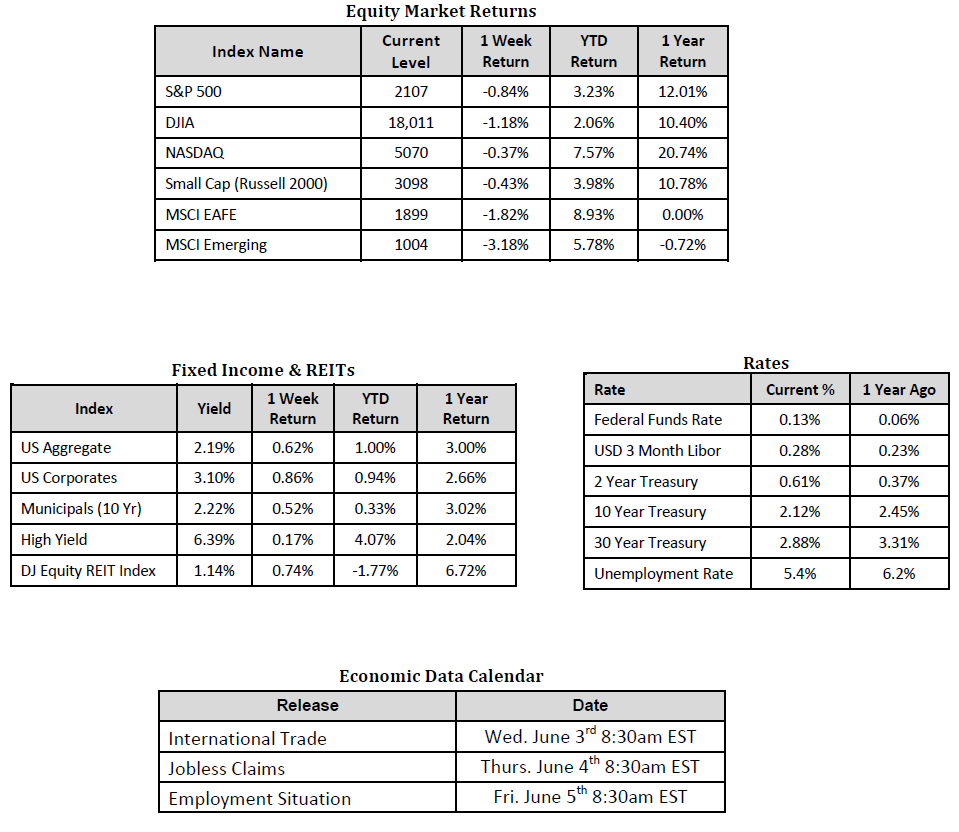
Greece Occupies Headlines with Less Contagion Risk
Market Overview
Sources: Equity Market, Fixed Income and REIT returns from JP Morgan as of 5/29/15. Rates and Economic Calendar Data from Bloomberg as of 6/1/15.
Happening Now
Greece Occupies Headlines with Less Contagion Risk
Headlines from just about every financial media outlet have had something to do with Greece recently as the four month extension on Greece’s bailout deal, cut in February, comes to an end. Greece owes the International Monetary Fund about €303 million on June 5, which they are at risk of being unable to afford, in addition to over €26 billion in payments due in 2015 alone. Since the newly elected Prime Minister Alexis Tsipras took office in January, Eurozone creditors have been negotiating new terms with the anti-austerity Greek government in an attempt to keep them from defaulting on their debt and in the 16 year* old monetary union. After months of lines being drawn, crossed and redrawn Greece seems no closer to a solution today than they did when the can was kicked down the road four months ago.
Despite the uncertainties surrounding the future of Greece, there seems to be limited risk of contagion to the periphery at this time. Relative to 2011, when not only Greece, but also Portugal, Italy, Ireland and Spain were facing deep economic troubles, sovereign bond yield are significantly lower. To illustrate this point the table below shows the average yield of 10-year government debt for each of the countries listed above in 2011 and 2015:
| 2011 | 2015 | |
| Portugal | 10.24% | 2.18% |
| Italy | 5.42% | 1.52% |
| Ireland | 9.58% | 1.16% |
| Greece | 15.75% | 9.48% |
| Spain | 5.44% | 1.53% |
Equity markets have also shown few signs of stress this year as the MSCI Europe Index is up almost 11% when measured in Euro’s year-to-date. This likely reflects moves made in the financial system to limit exposure to a Greek default in addition to the higher capital reserves held by banks globally resulting from the implementation of the Basel III standards.
While it is imperative to consider the many complications the Eurozone faces, neglecting to allocate funds to a region that is undergoing monetary easing and what appears to be starting an economic recovery can be a costly mistake. Geographic diversification can also offer investors the potential for better risk-adjusted returns when implemented appropriately.
*The European Monetary Union was started in 1999, however Greece joined in 2001.
Important Information and Disclaimers
Disclosures: Past performance does not guarantee future results. We have taken this information from sources that we believe to be reliable and accurate. Hennion and Walsh cannot guarantee the accuracy of said information and cannot be held liable.
Investing in foreign securities presents certain risks not associated with domestic investments, such as currency fluctuation, political and economic instability, and different accounting standards. This may result in greater share price volatility. These risks are heightened in emerging markets.
There are special risks associated with an investment in real estate, including credit risk, interest rate fluctuations and the impact of varied economic conditions. Distributions from REIT investments are taxed at the owner’s tax bracket.
The prices of small company and mid cap stocks are generally more volatile than large company stocks. They often involve higher risks because smaller companies may lack the management expertise, financial resources, product diversification and competitive strengths to endure adverse economic conditions.
Investing in commodities is not suitable for all investors. Exposure to the commodities markets may subject an investment to greater share price volatility than an investment in traditional equity or debt securities. Investments in commodities may be affected by changes in overall market movements, commodity index volatility, changes in interest rates or factors affecting a particular industry or commodity.
Products that invest in commodities may employ more complex strategies which may expose investors to additional risks.
Investing in fixed income securities involves certain risks such as market risk if sold prior to maturity and credit risk especially if investing in high yield bonds, which have lower ratings and are subject to greater volatility. All fixed income investments may be worth less than original cost upon redemption or maturity. Bond Prices fluctuate inversely to changes in interest rates. Therefore, a general rise in interest rates can result in the decline of the value of your investment.
Definitions
MSCI- EAFE: The Morgan Stanley Capital International Europe, Australasia and Far East Index, a free float-adjusted market capitalization index that is designed to measure developed-market equity performance, excluding the United States and Canada.
MSCI-Emerging Markets: The Morgan Stanley Capital International Emerging Market Index, is a free float-adjusted market capitalization index that is designed to measure the performance of global emerging markets of about 25 emerging economies.
Russell 3000: The Russell 3000 measures the performance of the 3000 largest US companies based on total market capitalization and represents about 98% of the investible US Equity market.
ML BOFA US Corp Mstr [Merill Lynch US Corporate Master]: The Merrill Lynch Corporate Master Market Index is a statistical composite tracking the performance of the entire US corporate bond market over time.
ML Muni Master [Merill Lynch US Corporate Master]: The Merrill Lynch Municipal Bond Master Index is a broad measure of the municipal fixed income market.
Investors cannot directly purchase any index.
LIBOR, London Interbank Offered Rate, is the rate of interest at which banks offer to lend money to one another in the wholesale money markets in London.
The Dow Jones Industrial Average is an unweighted index of 30 “blue-chip” industrial U.S. stocks.
The S&P Midcap 400 Index is a capitalization-weighted index measuring the performance of the mid-range sector of the U.S. stock market, and represents approximately 7% of the total market value of U.S. equities. Companies in the Index fall between S&P 500 Index and the S&P SmallCap 600 Index in size: between $1-4 billion.
DJ Equity REIT Index represents all publicly traded real estate investment trusts in the Dow Jones U.S. stock universe classified as Equity REITs according to the S&P Dow Jones Indices REIT Industry Classification Hierarchy. These companies are REITSs that primarily own and operate income-producing real estate.




